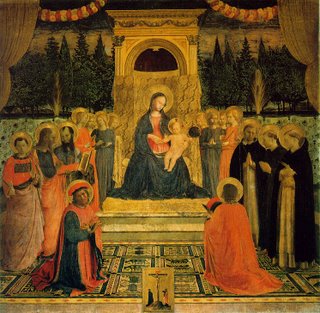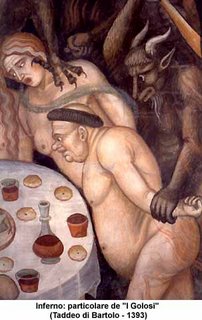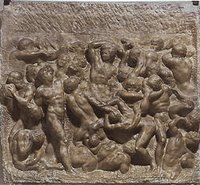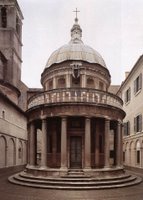How a Centuries-Old Fresco Is Removed From The Wall
A couple of months ago I visited the The Cloisters in Fort Tryon Park in upper Manhattan. The Cloisters is a branch of New York's Metropolitan Museum of Art, devoted to the art and architecture of mediaeval Europe. The construction of the neo-mediaeval building and its cloisters incorporated Romanesque and Gothic architectural fragments, dating from the eleventh through the fifteenth centuries, originating primarily in Spain and France. They were brought over from Europe in the 19thC by an American sculptor, George Grey Barnard, and assembled on this site as a museum for Barnard's collection, through the generosity of John D. Rockefeller, Jr.
A stone castle with cloistered gardens, set high on a bluff overlooking the Hudson River, the setting itself was worth the trip, and the mediaeval atmosphere added to my enjoyment of the art treasures on display: sculpture, tapestries, illuminated manuscripts, goldsmiths' and silversmiths' work, stained glass and enamels and ivories, and ... .
I joined a docent-led tour, which I found disappointing. It added little to what I already knew. I guess I was hoping for something along the lines of a
Jane's Smart Art Guide -- that is, more substance -- for the highly-motivated person who already has some background in the subject.
Our guide wasn't able to answer the one question I posed -- "How is a fresco removed from the wall it was originally painted on?" Not only did I think
he should have known, I realized that
I shouldn't have had to ask!
I've wondered this before, 'though never urgently enough to look into it. This time, however, the fresco in question had been painted on a curved wall, centuries ago, in Spain. It had been removed from that wall and transported across the ocean, to be integrated into the decoration of a chapel at The Cloisters -- still (or again?) curved! There was something about the fact that it had been removed from a curved support, rather than the usual flat wall, that pushed my curiosity over the brink, into research mode!
First, it helps to understand the fresco painting technique:
Unlike a mural, which is painted onto a dry wall surface, a fresco becomes part of the wall it's painted on -- literally part of the architecture. The fresco painter would begin by preparing the wall with a coat of coarse plaster, called “arriccio”. The Italian word “fresco” -- meaning wet or "cool” -- refers not to the paint but to the surface to which the paint is applied. The surface would be coated with a finely ground plaster, which was often mixed with marble dust to increase its smoothness. This plaster -- called “intonaco”-- would be applied in very thin layers over the arriccio, whose rough surface provided the necessary adhesion.
The paint used in these mural paintings, like all paint, is made of a colored powder or pigment suspended in a medium that makes it into a liquid, which becomes a paint film when it dries. In fresco painting, the binding medium is glue and limewater. When applied to wet plaster, the limewater causes the paint to bind with the wall itself. When dry, this sort of traditionally-applied fresco painting -- known as “buon fresco” -- becomes an actual part of the wall.
Because both the paint and plaster were quick to dry, this meant that painters had to plan to work in single sessions, on patches of fresh plaster: called “giornate,” after the Italian word meaning “day’s length.”
Art conservators have learned how to separate the intonaco layer of a fresco from the underlying arriccio. The technique had to be used, for example, to save a number of frescoes in Florence after the Arno flooded its banks in 1966 and damaged numerous important Renaissance works.
A fresco is removed from the wall by being transferred onto canvas, using what's known as the "Calicot method": invented by someone named Calicot, I presume. There are two processes used, depending on the condition of the underlying plaster:
"strappo da muro" = "pulling [of the fresco] from the wall" (strappare = to pull away) and "stacco" (staccare: to detach).
The stacco process detaches the fresco painting from the wall by removing the entire intonaco layer. A special water-soluble glue is applied to the painted surface and then two layers of cloth (calico and canvas) are applied. When the glue is dry, the cloth is peeled from the wall -- very carefully, I imagine! --pulling the painted intonaco with it. Once the fresco is off the wall, stuck to the cloth, it's taken to a laboratory where the excess plaster is scraped away and a fresh canvas is attached to the back with a permanent glue. This done, the water-soluble glue is dissolved and the cloths on the face of the fresco are removed. At this point, the fresco is ready to be mounted on a new support: the canvas stretched on a frame, like a regular painting, or glued to a solid base.
The strappo process is used when the plaster on which a fresco is painted has deteriorated badly. Strappo takes off only the color layer with very small amounts of plaster. The glue that's used in strappo is considerably stronger than that used in the stacco technique, but the procedure that follows is same. Sometimes when a fresco is removed by means of strappo, a colored imprint may still be seen on the plaster remaining on the wall, evidencing the depth to which the pigment originally penetrated the wet intonaco.
And that's how they managed to get The Cloisters' fresco off a curved wall, and back onto a curved wall!
 and beastly entertainments like gladiatorial combat were accepted. Paul himself, initially a persecutor of those Jews who believed in Christ as the Messiah, "saw the light" and became an apostolic messenger. Caravaggio represented Paul's conversion in this image in the Cerasi Chapel in Sta. Maria del Popolo in Rome.
and beastly entertainments like gladiatorial combat were accepted. Paul himself, initially a persecutor of those Jews who believed in Christ as the Messiah, "saw the light" and became an apostolic messenger. Caravaggio represented Paul's conversion in this image in the Cerasi Chapel in Sta. Maria del Popolo in Rome.




